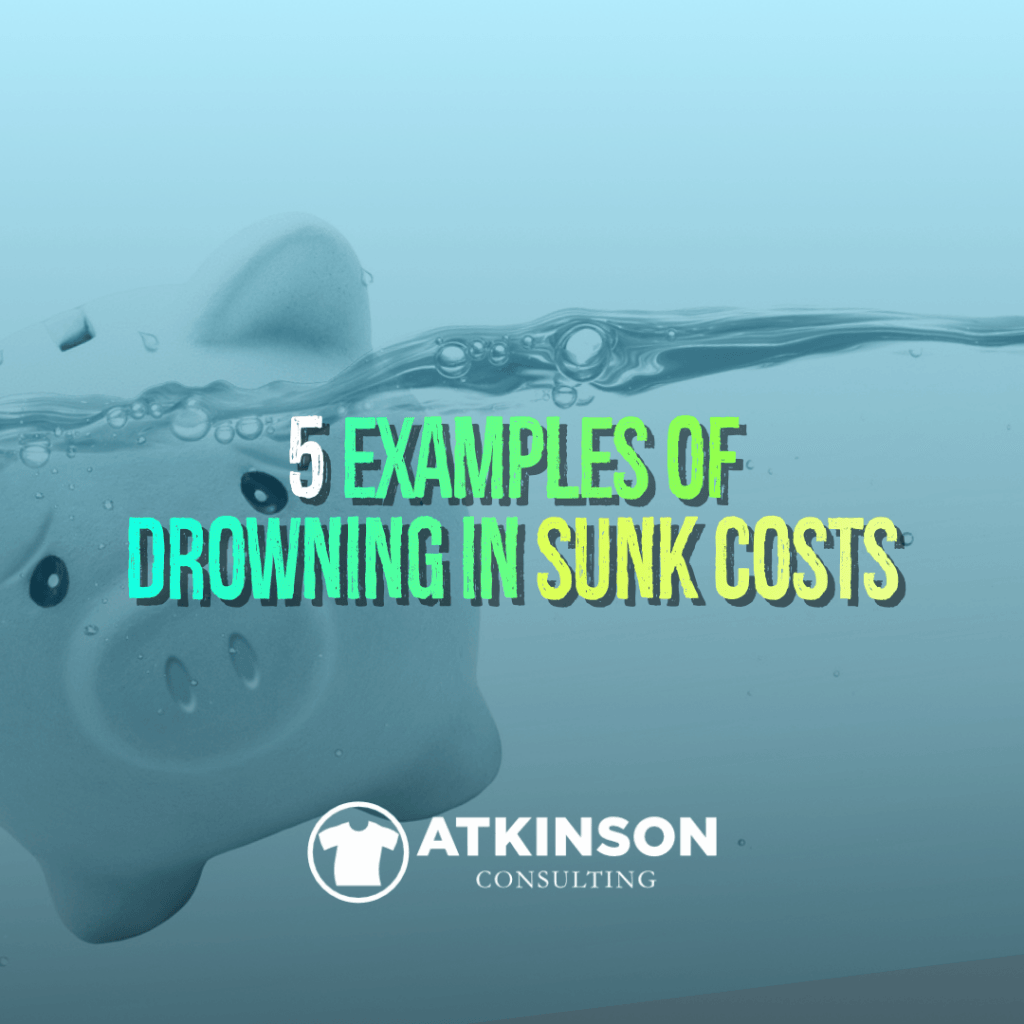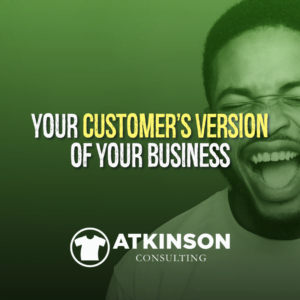Have you ever heard of the term “Sunk Costs”?
I know, it is not something that just rolls off of your tongue in everyday conversation. But in your shop, you may be dealing with a Sunk Cost idea right now.
Let me explain.
A simple definition for Sunk Costs is when a person or business spends money on something, and then they feel obligated to not change direction, even though it may be in their best interests to do something differently.
It is the challenge of inaction.
In your personal life, let’s say you bought a plane ticket to a tropical island for vacation months in advance. You spent the money and have wonderful dreams about a great getaway. Relaxing on the beach with an umbrella in your drink sounds good right about now, doesn’t it?
Then, the day before you are set to go, there is a hurricane warning for the island.
It definitely is going to hit.
But you fly there anyway. Because you spent the money. “I don’t want that ticket to go to waste.”
Sound a tad ridiculous? Probably.
But let’s take a look at these five examples in that same context for your shop:
Examples of Sunk Costs
Equipment
You purchased your equipment years ago. Even then it was used and not in mint condition.
Now, it’s barely hanging on.
You have to bring in techs a few times a year to keep giving it life support. Meanwhile, your production is down and this causes backups to your schedule.
You feel locked in because you have spent all that money on it. Heck, last month cost you over $1,500 alone. Buying something new feels like admitting defeat and throwing that money away.
Saving Stuff
The shop is cluttered with boxes and bins of who knows what. (…and why isn’t it labeled?)
It’s in the way, and instead of using the space for productive means, you hang onto this stuff “because one day you might need it”.
There isn’t a plan.
One day never comes.
In the meantime, the crew from the television show “Hoarders” is outside unpacking the camera from the van for a new episode about your shop.
An exaggeration? Maybe.
Walk out into your shop and ask yourself if you really need that stuff over there. What could you do with that space to make money instead?
Not Upgrading
Technology advances.
New software programs and techniques come out that could potentially drive tremendous value to your business. Some of these tools automate processes that you have your staff spend time on every day.
Instead of moving to newer, faster, and more powerful tools, you stick to the dinosaur method. “We bought this years ago! Do you know how expensive it was then?”, you say.
Part of the reason too is that the new tech seems difficult to understand. Half of the reason for not looking into things is that you don’t want to feel stupid.
Meanwhile, your employee count continues to grow.
Employee Hires
A few months ago you hired someone that at the time was an incredible pick.
Amazingly, you thought you won the employee lottery when they came on board. Now, their true colors are showing.
Ut oh.
However, you don’t feel you can part ways with them because you told everyone how happy you were to hire them. Now you feel stuck and conflicted.
What’s worse, inaction or admitting mistakes? You aren’t sure.
Websites
You paid a lot of money to have your website built. The struggle of getting that up and running is still vivid in your mind, even though that was quite a number of years ago.
Now, it looks fantastically outdated and doesn’t even work on a cell phone.
But, despite knowing that online technology has leapfrogged your business, you stick to the old website version.
Yet, your argument is that “Hey, it still works. Why should we update?”
It’s like a comfortable old shoe. They were incredibly expensive when you bought them.
But now?
The bottom sole is worn down, and there is a hole near the toe. Not to mention that funky smell that just doesn’t seem to go away.
But, you can still walk in them.
Just like your website. It still works.
Don’t mind that smell.
Stop
Take a look around you. I get it.
Money is hard to come by. However, are you preventing good things from happening not because of your fear of change, but because at one time there was a cash outlay for something?
‘I’ve already spent the money” may not be a defensible argument.
There isn’t anything to be embarrassed about. This is human nature 101.
It’s easy to be a victim of the sunk cost fallacy. As people, we get emotionally invested in money, time, people, or any other ideas that we have committed to in the past.
This has happened to me before.
It’s going to happen to you.
Free Yourself
The best way to unlock a better potential future is to simply wake up and take stock with a different perspective.
There are two words to use. “What if”.
What if is very powerful if used in the right context. Let’s look at those same examples through the “What if” lens.
What If…New Equipment Is Bought
The old junky model equipment is sold to an online used equipment dealer and carted off.
Brand new equipment replaces it.
Suddenly, daily production is up by 28% without changing any other part of the process.
This happens because that chunk of time the operator spent fiddling with the equipment to keep it running is now replaced with normal production. You know, actually doing the work as intended.
What’s interesting is that by a few weeks the production schedule is caught up, defects are down, there is less overtime, and also less expedited freight.
Even the crew seems happier. And that guy isn’t usually happy about anything.
What If…The Shop Was Decluttered
The idea that a Hoarders film crew would want to capture your craziness was a wake-up call.
You suddenly see the impact of keeping too much stuff has to the productivity of the business. At one time, staff had to wade through the mess.
Now, it feels like a heavy weight has been lifted from the shop.
There is so much space!
File cabinets are no longer needed as everything on paper goes digital. Broken equipment and skids of unusable computers, printers, and office junk are recycled. Other items such as unclaimed apparel samples, misprinted shirts, and other miscellaneous items are donated to a local charity.
For the first time in years, you can see the walls and the floor in some areas. This sparks a spring cleaning revolution.
In a month, the entire shop looks brand new. Letting go of all of that crap was one of the best decisions you’ve made all year.
You feel invigorated.
You aren’t embarrassed to give shop tours any longer, and even have your first Open House for your customers.
Ever.
What If…You Invested In Technology
Yes, it was a little expensive but your shop invests in the hardware and software to go paperless.
Now, everything in the shop is updated real time.
With a lot of effort and communication, the workflow process improves. Touchscreens and digital interfaces replace printed paper. Data is collected, and real costs are kept on orders.
Worker accountability increases, as there is “no hiding” from when things are due, or even how long it takes to perform tasks. Every movement is tracked and updated.
Production managers manage the schedule from their phone.
Problems are proactively handled in advance. Plus, there are plenty of notes in the system to understand what occurred four months ago when someone calls in with a question.
A few weeks in, you wonder out loud, “How did we ever do it any other way?”
What If…You Hired Slow Fired Fast
After careful consideration, the entire hiring process was revamped.
The old way was essentially looking for warm bodies to perform tasks. Looking back you shake your head at some of the dumb hires that were made.
Now, more time is spent during the hiring event to make sure that the potential candidate can not only perform the duties of the open slot but could possibly be right for positions three or four levels above that one.
What really pushes change is with the conversations with the new hires that outline explicit expectations for the position early. Training and mentoring programs are built to augment the process.
If a new hire looks like the training isn’t going smoothly, or there are other things that surface, these are dealt with in a new procedure.
This process either corrects the issue, or the employee is transitioned out of the job.
Because more emphasis has been placed on not only finding the right people for the bus but making sure they are in the right seat, employee engagement and satisfaction have increased.
Performance is up, errors are down.
All because of the emphasis on finding the right people.
What If…You Embraced Online Sales
It is a hard pill to swallow, but you finally embraced the idea of online sales.
You realize that everything now is driven by Google Analytics, SEO, and Facebook Pixels.
A few months ago, you barely understood those terms. Now you have come to realize that there is a reason your walk-in traffic has slowed.
That’s not how people buy any longer.
You then scrapped your current website and had a new one constructed. This one is loaded with tools and SEO building choices. Data collection becomes key to decision making.
Adding to that initiative is an overhaul of your marketing too. Customers are segmented into automated outreach campaigns.
Coupled with these new ideas, online sales start to rise, and in no time at all resemble the famed “hockey stick growth” that everyone covets.
Your proudest moment happens when you notice that one order came in at 3:23 am on a Saturday and you didn’t have to do anything.
It just appeared. You didn’t even have to quote it.
That one order was the start of a new trend for your shop.
These Are Just Examples
So what sunk costs are you hanging onto in your shop with a white-knuckle death grip? I’ll bet there is something.
Probably a lot of things actually.
Do yourself a favor and start asking your own versions of “What if?” How much better could something be if you made a change?
Don’t let sunk costs get in the way of your forward progress. Embrace being uncomfortable and asking a hard question or two.
On the other side of that question could be the answer that solves everything.
What if…
“We keep moving forward, opening new doors, and doing new things, because we’re curious and curiosity keeps leading us down new paths.” – Walt Disney
“There are risks and costs to action. But they are far less than the long-range risks of comfortable inaction.” – John F. Kennedy
“There is nothing either good or bad but thinking makes it so.” – William Shakespeare
“Price for Profit”

Are you using the “Average of all of the shops around me” as the basis for your price list because you never learned to do it properly?
Do you have a firm grasp of what it costs you every day to run your apparel screen-printing shop?
How does the average cost per impression for what you do factor into more profit?
What are some ways you can charge more for what you do and increase your revenue?
This $59 eBook is written for shops to help demystify how to construct a pricing list that will ensure profitability.
It contains easy to follow, step by step instructions on how to run your shop better.
Whether you are new to the business or a seasoned veteran of the industry, this best-selling eBook can help you understand pricing strategies that work.
Click Here to grab your downloadable eBook today for $59





